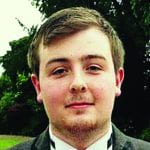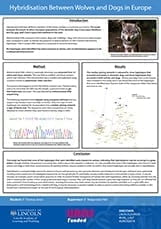By Thomas Jones //
 UROS has been an excellent opportunity, allowing me to hone my field-specific skills and other transferable skills, both of which will serve me well in the future. Having already undertaken some work experience with my UROS supervisor in my first year, I wanted to continue this work in my second year as not only did I find the topic itself very interesting, but working in an active research laboratory was both exciting and insightful. The opportunity to design a project, undertake actual research and present the culmination of it to the public has greatly increased my confidence to engage in real-world science on an independent level, thus the whole UROS experience has reinforced my aims to continue studying at a postgraduate level.
UROS has been an excellent opportunity, allowing me to hone my field-specific skills and other transferable skills, both of which will serve me well in the future. Having already undertaken some work experience with my UROS supervisor in my first year, I wanted to continue this work in my second year as not only did I find the topic itself very interesting, but working in an active research laboratory was both exciting and insightful. The opportunity to design a project, undertake actual research and present the culmination of it to the public has greatly increased my confidence to engage in real-world science on an independent level, thus the whole UROS experience has reinforced my aims to continue studying at a postgraduate level.
My project aimed to confirm the extent of canid hybridisation in Europe. Canis lupus lupus and Canis lupus familiaris hybridisation has been well documented across Europe both spatially and temporally. This long-term admixture between the two subspecies has resulted in a loss of genetic distinctiveness in the wolf genepool as many different haplotypes were found not to be exclusive to wolves. My project highlights the need for changes in both conservation strategy and the legal protection afforded to wolf-dog hybrids across Europe. Wolves are a keystone-species and their removal by illegal hunting would most likely have a detrimental impact on other species and the environment in which the wolves inhabit as wolf populations are low in many European countries or regionally extinct in others.
I spent the first week of my project acclimatising to working independently in a laboratory, and though I was familiar with many of the molecular techniques I was to use over the duration of my project, my supervisor was always on hand to help me if I needed it. I spent a further four weeks working in the laboratory on miscellaneous tasks including DNA extraction, DNA quantification, Polymerase Chain Reaction, Gel Electrophoresis, UV imaging and DNA purification. Learning all of these procedures was immensely rewarding, as even though lab work in a working laboratory was a steep learning curve, I am now much more confident for my dissertation and beyond. The second phase of my research involved roughly a month of computer analysis using various software such as MEGA, BLAST and Network. This was another challenge in itself but the conclusions that I could draw from the resulting data made everything worthwhile.
My project has been time-consuming and stressful at times, but I would highly recommend undertaking a UROS project. I have proved to myself that I can work at a high level alongside distinguished academics to produce good quality research, something that I hope that I can continue doing into the future. The UROS scheme has given me a new understanding of how rewarding research can be. Collaborating with my supervisor has been a great experience as I know that my research will supplement their future published work, meaning that I have played a role in world-class scientific research, however small that role may be.
*To view Thomas’s project poster, please click on the thumbnail below:
